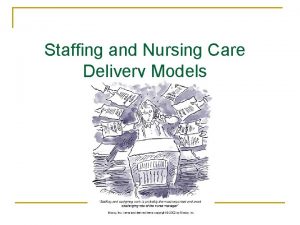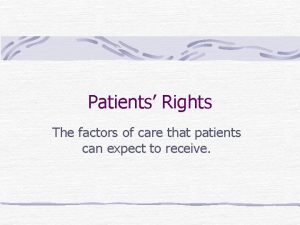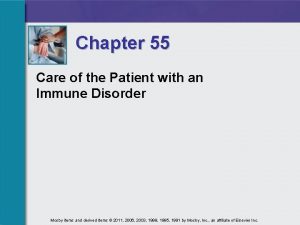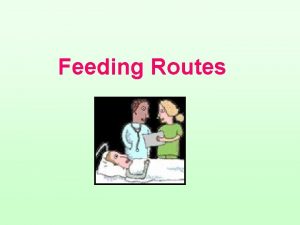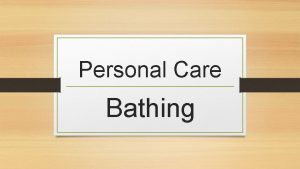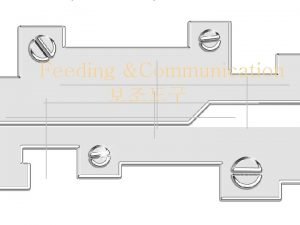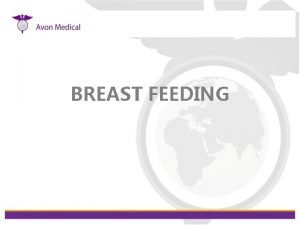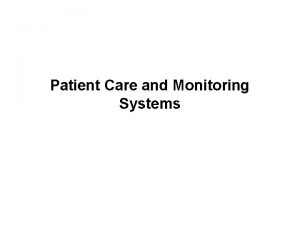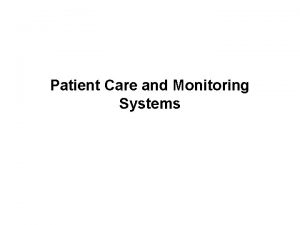Personal Care Feeding a Patient Feeding a Patient










- Slides: 10

Personal Care Feeding a Patient

Feeding a Patient • Good nutrition is an important part of a pt’s treatment • Meals are often a time for social interaction for most people • Pts who eat alone are more at risk for having poor appetites & poor nutrition • Residents of LTC facilities are encouraged to eat in the dining room • If a pt is confined to bed, it is important to talk with the pt while serving the tray or feeding the pt

Feeding a Patient Steps to assisting a patient with meals: • • Preparation for tray Tray delivery Setting up the tray Feeding the pt

Preparing for the Tray • • • Offer the bedpan/urinal or assist pt to the bathroom Allow pt to wash hands and face (if desired) Provide oral hygiene if desired Help pt to a sitting position if possible Clear the overbed table Remove objects such as emesis basin or bedpan from the pt’s view

Tray Delivery • Make sure pt understands if meal will be delayed due to X-rays or tests • Check the tray against the pt’s name, room number, & type of diet ordered • If anything is out of place (salt with a salt-free diet or sugar with a diabetic diet) check with your supervisor or the dietitian • Never add any food to the tray without checking the diet order first

Setting up the tray • Make sure all food and utensils are within reach • If necessary, assist by cutting meat, opening beverage cartons, and buttering bread • If pt is visually impaired, tell them what food is on the plate by comparing the plate to a clock

Feeding a Patient • Test the temperature of all hot foods by placing a small amount on your wrist – never blow on hot food to cool it • Alternate the foods by giving sips of liquids between solid foods • Use straws for liquids unless the pt has dysphagia (difficulty in swallowing). Straws can force liquids down the throat faster and cause choking • Use food thickener to solidify liquids if ordered by physician or dietitian

Feeding a Patient • Only offer small bites of food at one time, filling the spoon/fork 1/3 -1/2 full • Hold the spoon/fork at right angles to the pt’s mouth so you are feeding the pt from the tip of the utensil • Encourage pt to eat as much as possible • Provide a relaxed, unhurried atmosphere • Give pt sufficient time to chew

Feeding a Patient • Observe how much pt eats so you can record it • If pt doesn’t like a food on their tray, ask supervisor or dietitian whether a substitute can be provided • Be alert to signs of choking

Feeding a Patient • Provide liquids to keep mouth moist to make chewing & swallowing easier • If pt has had a stroke, one side of mouth may be affecteddirect food to the unaffected side • In stroke pt, watch pt’s throat to check for swallowing and check for food that may be lodged in the affected side of the mouth
 Specialized nutritional support
Specialized nutritional support Levels of care primary secondary tertiary
Levels of care primary secondary tertiary Patient 2 patient
Patient 2 patient Team nursing and modular nursing
Team nursing and modular nursing What is a disadvantage of functional nursing?
What is a disadvantage of functional nursing? Qsen safety competencies examples
Qsen safety competencies examples Progressive patient care model
Progressive patient care model The factors of care that patient can expect
The factors of care that patient can expect Postoperative nursing care plan for eye surgery
Postoperative nursing care plan for eye surgery Nursing care plan for hoarding disorder
Nursing care plan for hoarding disorder Chapter 55 care of the patient with an immune disorder
Chapter 55 care of the patient with an immune disorder




